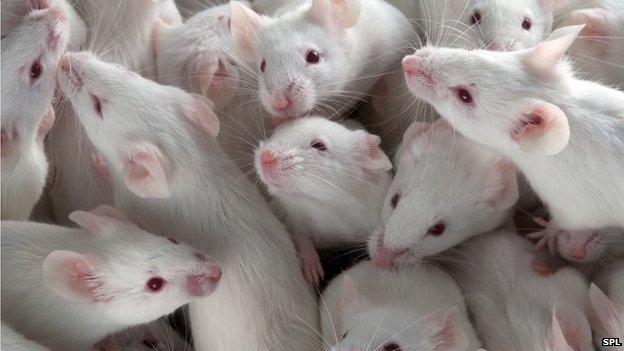'No target' in UK animal tests plan
- Published

The UK government has launched its delivery plan, external to replace, refine and reduce the use of animals in research - known as "the 3Rs".
It pledges to encourage scientists to use alternatives wherever possible.
But there is no commitment in the strategy released on Friday to reduce the total number of animal experiments, which has been on the rise.
This is despite a post-election pledge by the Coalition to cut the use of animals, external in scientific research.
Instead, the government will promote new, more ethical research techniques which can help boost UK science.
"This isn't about a numerical target," said David Willetts, Minister for Universities and Science.
"The commitment is to 'work to reduce use of animals'. Ultimately the final figure will depend on patterns of scientific advance.
"Britain is a world leader in science but also in concern for the welfare of animals. What we are doing is bringing these two great British traditions together.
"We are absolutely committed to the 3Rs."
'Artificial' focus
Crime Prevention Minister Norman Baker, who is leading the Home Office work, said it would be "artificial" to focus on the absolute numbers of animal experiments.
"Had work not been done via the 3Rs we'd already have a higher number," he said.
"If we are attracting scientists from overseas because of our good scientific base, that will impact the total figure.
"Minimising the use of animals can also be an opportunity for the science sector.
"I challenge you to find a document like this anywhere else in the world."
However, the British Union for the Abolition of Vivisection (Buav), which campaigns to end animal testing, called the strategy a "missed opportunity".
Buav's chief executive, Michelle Thew, said: "This is a whitewash and shows that the Government has in reality given up on what it promised to do and that is to reduce the number of animal experiments.
"This broken promise is a missed opportunity for the Government to make meaningful and lasting change for the millions of animals that are suffering in UK laboratories."
Jan Creamer, chief executive of the National Anti-Vivisection Society (Navs) commented: "Incredibly, the Government report admits the failings of animal research, yet claims to be powerless to move towards what it calls the 'better, faster and cheaper non-animal approaches'."
Continued rise
But the Humane Society International (HSI), an animal protection organisation, gave the government's plan a cautious welcome.
Emily McIvor, its animal research policy director, said: "The Plan itself recognises the desperate impasse in drug development, where 92% of new medicines tested on animals fail in human trials.
"It also highlights barriers posed by underlying conservatism among journal editors and peer review panels that needs to be overcome if progress is to be made."
Wendy Jarrett, chief executive of Understanding Animal Research, which works to promote understanding about advances stemming from animal testing, said: "We welcome this very clear cross-government statement of the continuing need for well-regulated animal research in the UK."
The BioIndustry Association (BIA) responded positively to the plan, but its chief executive Steve Bates, said: "Government must ensure that any actions it takes do not negatively impact the ability of British companies to continue to research and develop new products and technologies."
Despite the Coalition's 2010 pledge in its Our Programme for Government document, the number of animal experiments has continued to rise steadily.
Latest figures show they rose by 8% in 2012, fuelled by a growth in the use of genetically modified (GM) animals.
About 4.11 million scientific experiments on animals took place in 2012, an increase of 317,200 on the previous year, according to a Home Office report.
Mice were the most frequent animals used, followed by rats, fish and primates such as Old World Monkeys, a group which includes macaques and baboons.
- Published16 July 2013
- Published14 March 2012
- Published28 January 2014
- Published10 December 2013